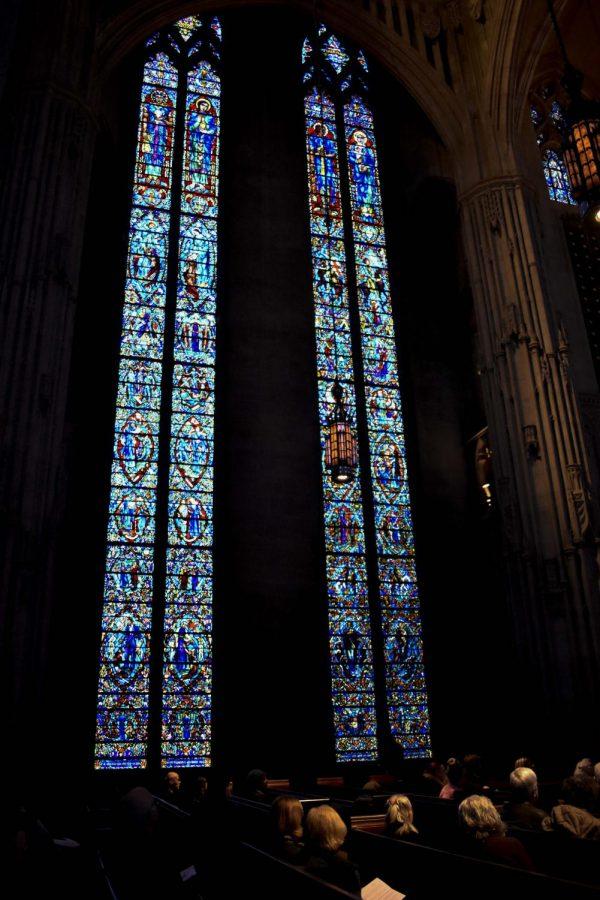Heinz Chapel shines light on women’s history
Romita Das | Staff Photographer
Heinz Chapel hosted “Women in Windows” yesterday, a small tour describing women’s depictions in stained glass windows in the chapel to honor Women’s History Month.
March 2, 2020
Apart from their historical importance, Emily Dickinson, Joan of Arc and Florence Nightingale all share one thing in common — they’re featured figures on the windows of Heinz Chapel.
Heinz Chapel hosted its first, one-hour “Women in Windows” tour on Sunday afternoon. The free tour, which will be held on Tuesdays at noon throughout March, serves to educate the public on several influential but lesser-known female portraits within the chapel’s four tall stained glass windows. Chapel docent and event coordinator Karen Sebolt organized the event to honor Women’s History Month.
There are 65 women featured in the 23 stained-glass windows of Heinz Chapel, designed by Charles J. Connick as a testament to Heinz’s values. The four central windows each represent a different theme — tolerance, courage, temperance and truth, from left to right — accompanied by images chosen to depict each concept. Sebolt hosted the event and provided the history behind each panel.
“You’ll notice that it’s not just saints and biblical figures, but activists, writers, nobility, Native Americans and all types of women are represented,” Sebolt said. “They’re not just minor characters here.”
The number of women featured in the windows is equal to the number of men. Sebolt speculated that this example of equal gender representation in the early 20th century could have been the result of the increased presence of women in Pitt’s staff during its commission — several of whom served on the Chapel’s design committee. Pitt hired Blossom Henry, the first female faculty worker, in 1918 and Thyrsa Amos, the first dean of women, in 1919.
“The committee to design Heinz Chapel included the dean of women, Thyrsa Amos, so maybe that’s why there is equal distribution in these windows,” she said. “Or maybe it’s because the chapel was dedicated to Anna Margaretta Heinz, Heinz’s mother.”
The tour of important but lesser-known female portraits began with the tolerance glass, highlighting prison reform advocate Elizabeth Fry, the “Angel of Prisons.” Depicted in a blue dress and comforting an emaciated female prisoner, Fry advocated for the separation of imprisoned men and women, the education of female prisoners and the improvement of prison living conditions in 19th-century Europe.
The first woman to ever address Parliament in 1818, Fry condemned the inhumane conditions in prisons and campaigned for the privacy of prisoners being transported from the courthouse to the prison, as people would often throw rotten food through the open carriages. She also opened a nurse training school, whose graduates accompanied Florence Nightingale during the Crimean War.
Surveying the tolerance glass window, Naomi Mekeel, a web developer for the philanthropic and alumni engagement department at Pitt, said the tour was a great way to kick off Women’s History Month.
“I think it’s important that the college has a nondenominational chapter, and I love hearing that there was equal gender representation, even in the ’30s,” she said.
Sebolt then guided the audience toward the portrait of a woman in a purple cloak on the courage glass, carrying a child on her hip and holding the hand of another child. Sebolt identified the woman and children as members of the Brodhead family, the first people of European descent to settle in the area now known as East Stroudsburg in 1737.
The next stained glass window, temperance, showcased the biblical figure Ruth, depicted at the top of the window holding wheat. Her story follows her and her mother-in-law Naomi, who must travel back to Bethlehem because she has no male relative in Moab. Despite the extreme poverty, famine and hardships that accompanied the trip, Ruth remained loyal to Naomi and refused to leave her side.
“We’re not sure who the author was of Ruth’s book, but it’s believed that it was written around 90 B.C.,” Sebolt said. “She is one of the people in the genealogy of Jesus.”
Sebolt then led the tour to the truth window and highlighted the English educator, abolitionist and writer Hannah More. In the image, More is reading to a young child and overseeing a classroom. More worked as a teacher at her father’s all-girl boarding school until her ex-fiance agreed to supplement her income after breaking off their engagement, allowing her to concentrate on writing plays and poetry.
As her writing circulated throughout London, she became a member of the elite Blue Stockings Society, an educational and social group for women. A vocal abolitionist, she frequently highlighted the atrocities committed by the slavery institution in her writings.
After the four-window showcase, tourists then explored the chapel, accompanied by organ music composed by two deceased female hymn lyricists, Sarah Flower Adams and Fanny Crosby.
Sam Amberg, an employee at Pitt’s communications and web services department, said the event allowed her to learn more about Heinz Chapel and women’s history.
“All of the detail in the panels, especially the roundels, try and capture all of the dimensions of the story, and I don’t know if I could have understood that without the tour today,” Amberg said.
This, Sebolt explained, is the purpose of Heinz Chapel — to be an educational resource to the Pitt community.
“It’s a nondenominational chapel open to all faces and backgrounds,” she said. “It’s really a gift for the students to use on a daily basis.”



